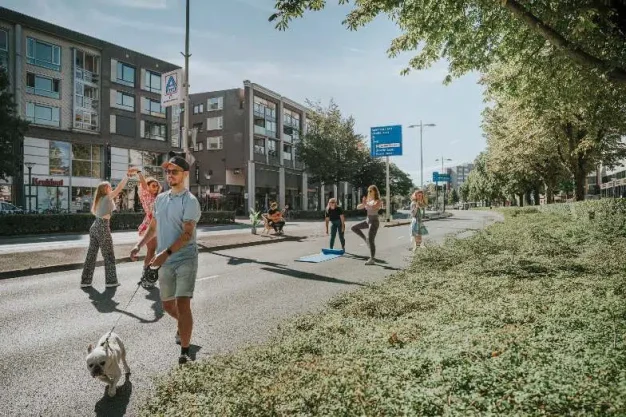
Can you go car-free? Child-friendly cities get creative for European Mobility Week
Creating child-friendly neighbourhoods was a core part of this year’s European Mobility Week where citizens across Europe were asked to consider one simple question – could you adapt your mode of transport to travel sustainably for a week?
Today, 22 September, is the last day of an initiative involving hundreds of European cities and towns participating in the European Commission’s campaign to encourage ‘behavioural change in favour of active mobility, such as walking and cycling, public transport, and other clean, intelligent transport solutions.
Better Connections has been theme of this year’s campaign, so chosen to reflect a collective desire from people to reconnect with others after the best part of two years of isolation, restrictions and constraints to their daily lives.
Connected through public transport
Kim Vo is from the Ministry of Mobility and Public Works in the Grand Duchy of Luxembourg, where public transport has been free to all citizens since 2020. “The choice of this year’s theme reflects people’s desire to reconnect with each other across Europe, after months of isolation, restrictions and constraints. Thanks to public transport, people have the means to stay connected,” she said.
Luxembourg is a prime example of a country taking a starring role this week – with children very much in mind. The town of Ell, for instance, invited school pupils to ‘Pimp your bus shelter’ by decorating them with washable colours. The city of Esch-sur-Alzette went car-free for a day, while in Schuttrange, citizens travelling by modes such as bike or public transport were treated to local pastries.
Sustainable mobility for a healthier future
Meanwhile in the Netherlands, the Province of Utrecht organised a host of activities including bike puzzle tours, a cycle ride with the Bicycle Mayor of Utrecht – a person selected to be the face and voice of cycling progress in a city – reductions on bus tickets and bike-sharing services. Amersfoort closed off part of a busy road to motorised traffic for three consecutive evenings, and the constant hum of cars was replaced by the sound of music, sports and games.
Marjolein Antonides, Campaign Coordinator and Communications Specialist for the Province of Utrecht, said: “To keep our province accessible, green, and healthy, we are encouraging the use of sustainable mobility. Sustainable mobility is good for the environment and takes up less space in our busy cities and province. And if you choose to cycle or walk, it’s also good for your health.”
Child-friendly mobility

In the Brussels-Capital Region in Belgium, the theme for this year was ‘For a child-friendly city’. Local leaders say that over the past 15 years, more and more young people have been making their way to schools in the Brussels region by bike and public transport.
Fewer are travelling by car, with 62 per cent of primary and 84 per cent of secondary school pupils taking alternative modes of transport at least every other day. Brussels Mobility, the local government arm which oversees mobility issues, says it wants to see more young people able to move actively and safely around the city. It has set a target of increasing these figures to 70 per cent and 90 per cent respectively by 2030.
“Rethinking public space by taking into account the needs of children means rethinking mobility for a more inclusive city for the benefit of all,” said Camille Thiry, Head of Communication for Brussels Mobility.
Pupils took part in a ‘To school without my car’ challenge, encouraging them go to school by foot or bike. Sunday September 18 saw the Brussels-Capital region become the largest area closed to cars in Europe as part of ‘Car-Free Sunday’.
Safer streets as a human right
The United Nations says safer roads are an essential part of the shift to greener mobility, and its campaign ‘Streets for life’ is designed to deliver a world where, ultimately, neighbourhood streets are safe, healthy, green and liveable. As part of the New Decade of Action for Road Safety, the global campaign has the goal of reducing the number of victims on roads in half by 2030.
“Road safety is a fundamental human right. It is essential for economic development, access to healthcare and education, and mitigation of climate change,” said United Nations Special Envoy for Road Safety Jean Todt.
Low speed streets, particularly in urban areas, are key so people can walk, live and play freely. If a collision occurs, the consequences are less serious at a lower speed. Since January 2021, cars in Brussels must respect a maximum speed limit of 30 km/h in most of the city’s streets. The ‘30 City scheme’ also seeks to improve health and reduce noise pollution. Other European cities to have introduced city-wide 30 km/h limits include Grenoble and Lille in France, and Bilbao and Valencia in Spain.
Luxembourg has introduced measures that include traffic calming, the development of 20 km/h and 30 km/h zones and new infrastructure for cyclists. In the Netherlands, Utrecht is focusing on 3 ‘Es’ to improve road safety: Engineering, Education and Enforcement. This involves identifying locations that have an increased risk of accidents; raising awareness; and strengthening compliance with traffic rules.
Jean Todt added: “Safe mobility is a shared responsibility and today we need commitment from all leaders and members of the public to create safer streets for all.”




